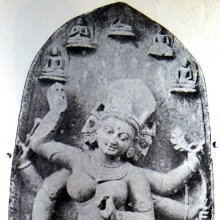Parnashavari, Parṇaśavarī, Parna-shavari: 2 definitions
Introduction:
Parnashavari means something in Buddhism, Pali. If you want to know the exact meaning, history, etymology or English translation of this term then check out the descriptions on this page. Add your comment or reference to a book if you want to contribute to this summary article.
The Sanskrit term Parṇaśavarī can be transliterated into English as Parnasavari or Parnashavari, using the IAST transliteration scheme (?).
Images (photo gallery)
In Buddhism
Tibetan Buddhism (Vajrayana or tantric Buddhism)
Source: Wisdom Library: Tibetan BuddhismParṇaśavarī (पर्णशवरी) is the name of Vidyārājñī (i.e., “wisdom queen”) mentioned as attending the teachings in the 6th century Mañjuśrīmūlakalpa: one of the largest Kriyā Tantras devoted to Mañjuśrī (the Bodhisattva of wisdom) representing an encyclopedia of knowledge primarily concerned with ritualistic elements in Buddhism. The teachings in this text originate from Mañjuśrī and were taught to and by Buddha Śākyamuni in the presence of a large audience (including Parṇaśavarī).

Tibetan Buddhism includes schools such as Nyingma, Kadampa, Kagyu and Gelug. Their primary canon of literature is divided in two broad categories: The Kangyur, which consists of Buddha’s words, and the Tengyur, which includes commentaries from various sources. Esotericism and tantra techniques (vajrayāna) are collected indepently.
General definition (in Buddhism)
Source: Cambridge Digital Library: Pañcarakṣā, SaptavāraParṇaśavarī (पर्णशवरी) (Parṇaśabarī) or Prajñāpāramitā refers to the fifth of “seven days” (saptavāra) classified as a dhāraṇī according to a 17th-century Sanskrit manuscript from Nepal .—This collection associates each dhāraṇī with a specific day of the week, a tradition going back to at least the sixteenth century in Nepal.
See also (Relevant definitions)
Partial matches: Savari, Parna, Cavari.
Full-text: Saptavara, Prajnaparamita, Parnashabari.
Relevant text
Search found 3 books and stories containing Parnashavari, Parṇaśavarī, Parna-shavari, Parṇa-śavarī, Parnasavari, Parna-savari; (plurals include: Parnashavaris, Parṇaśavarīs, shavaris, śavarīs, Parnasavaris, savaris). You can also click to the full overview containing English textual excerpts. Below are direct links for the most relevant articles:
The Indian Buddhist Iconography (by Benoytosh Bhattachacharyya)
The gods of northern Buddhism (by Alice Getty)
Lord Hayagriva in Sanskrit Literature (by Anindita Adhikari)
Yoginī Tantra < [Chapter 6]
